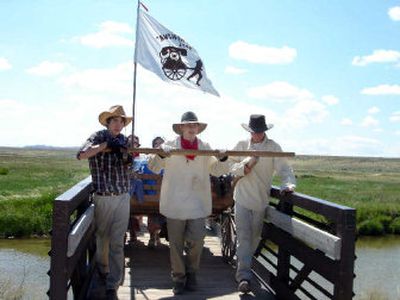Rewarding re-enactment

Many people are familiar with cholera and dysentery. They know about dead oxen, overturned wagons, and starvation. They’ve seen it all in the “Oregon Trail” computer game. What they may not know was that there was also a Mormon Trail, one every bit as harsh as its northern cousin.
Some 215 members, including 180 teens, of the Coeur d’Alene stake of the Church of Jesus Christ of Latter-day Saints re-enacted that trail last month. After a year of preparation, they spent three days pulling heavy handcarts across 24 miles of rugged Wyoming terrain. It was far harder than a normal summer camp, but that just made the experience even more rewarding.
Between 1856 and 1860, 3,000 Mormon pioneers traveled to Utah to find religious freedom. Unable to afford covered wagons or oxen, they used wooden handcarts. Most of the trail companies made it to Salt Lake successfully, but the Willie and Martin Handcart Companies met disaster in 1856. A harsh winter and lack of supplies killed more than 200 of the 1,000 pioneers.
The 215 Coeur d’Alene residents joined more than 2,000 others in commemorating the journey’s 150th anniversary. They divided themselves into “families” of up to 10 students and an adult Ma and Pa. Each person put 15 pounds of gear into the handcart, which they pulled behind them for 24 miles and through one crossing of the Sweetwater River. They wore period costume; the girls made their own dresses.
As they traveled, the teens heard about the original pioneers and the hardships they faced.
“When loved ones died, they had to bury them in the (deep) snow because they couldn’t reach the ground. They could hear the wolves coming and carrying their loved ones away,” said Briana Argo, 17.
Kelsey Smidt, 15, added, “I could actually feel it, all the pain and sadness and all the hard times they were having.”
For students whose own ancestors had made the journey, the stories were more personal. Sixteen-year-old Hannah Loumeau’s great-great-great grandparents were found “side by side, her head was resting on his shoulder. They froze to death.”
While such stories were hard for the re-enactors to listen to, almost all said the trip’s toughest part was the Women’s Pull. At one point during the trek, the boys were taken away to learn about the importance of family and their own role in the Church. The women were left to pull their carts up the trail’s steepest hill alone. The feat brought many of them to tears.
“When you’re really exhausted and you’re at home doing a sport or something, you can just stop, but the pioneers couldn’t just stop,” Loumeau said. “Even if it’s just a mental factor, you know you can’t stop, that you have to keep going.”
Even the men called the Women’s Pull the hardest part of the trek: Watching from a distance brought them to tears, too.
The Pull had an added dimension for Jenna Hancen, 15, and her mother, Mary. Jenna’s father died last October.
“The Women’s Pull was very symbolic for me and for Jenna, because we are literally pulling our cart,” Mary Hancen said. “That’s what we came away with – we can do this, no matter how hard it is, no matter how hard our lives seem.”
Jenna said her father’s death was on her mind the whole trek. “I just kept thinking, ‘What if I were a pioneer?’ Like right now, what if my father died on this trek? Would I be able to leave him in the snow? Would I be able to keep going?”
Every person took away something different from the experience. Most came away with a deeper appreciation for their pioneer ancestors and for their families. Many learned they could do more with their own bodies than they thought. Jenna has asthma, but managed to walk the entire 24 miles anyway. Spiritual growth was another common theme. Re-enactors shared testimony with one another, growing and learning as a group.
Spencer Pingle, 17, was surprised at what he learned.
“I was being looked up to as an example, especially for the little kids in my family,” he said. “They didn’t want to push or pull … and they really looked up to me. I can take that back with me to school … I’m what (other students) base their opinions of the church on.”
Matthew Hall, 13, agreed with Pingle. “I’ve never really looked up to anyone younger than 20 before. It was really awesome how hard they worked. I gained a few role models.”
Almost everyone said they would make the trip again. Their parents were surprised and impressed by this can-do attitude.
Scott Pingle, Spencer’s dad and a counselor in the Coeur d’Alene Stake presidency, said, “To say that we completely understand what the pioneers went through would be almost ridiculous. It was a drop in the bucket, but that drop has flavored our lives (and) changed a lot of us. We learned that these kids were the greatest kids, and that they can do a lot more than we thought they could.”